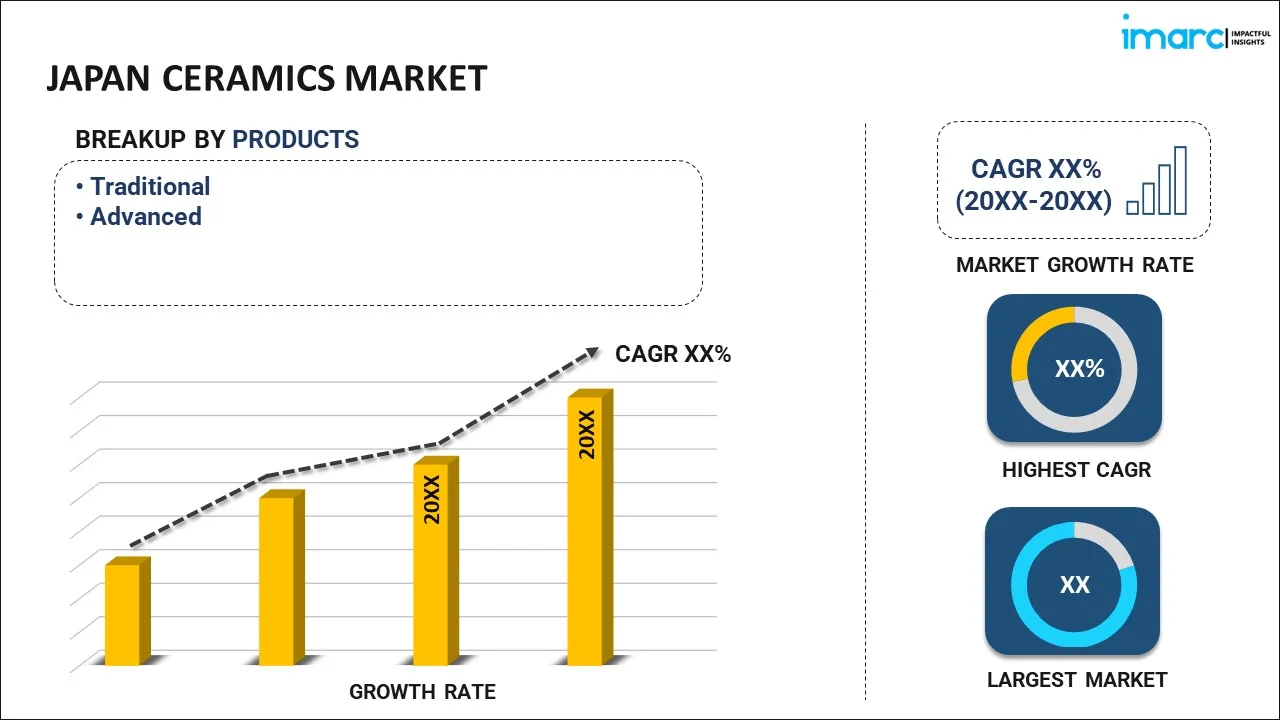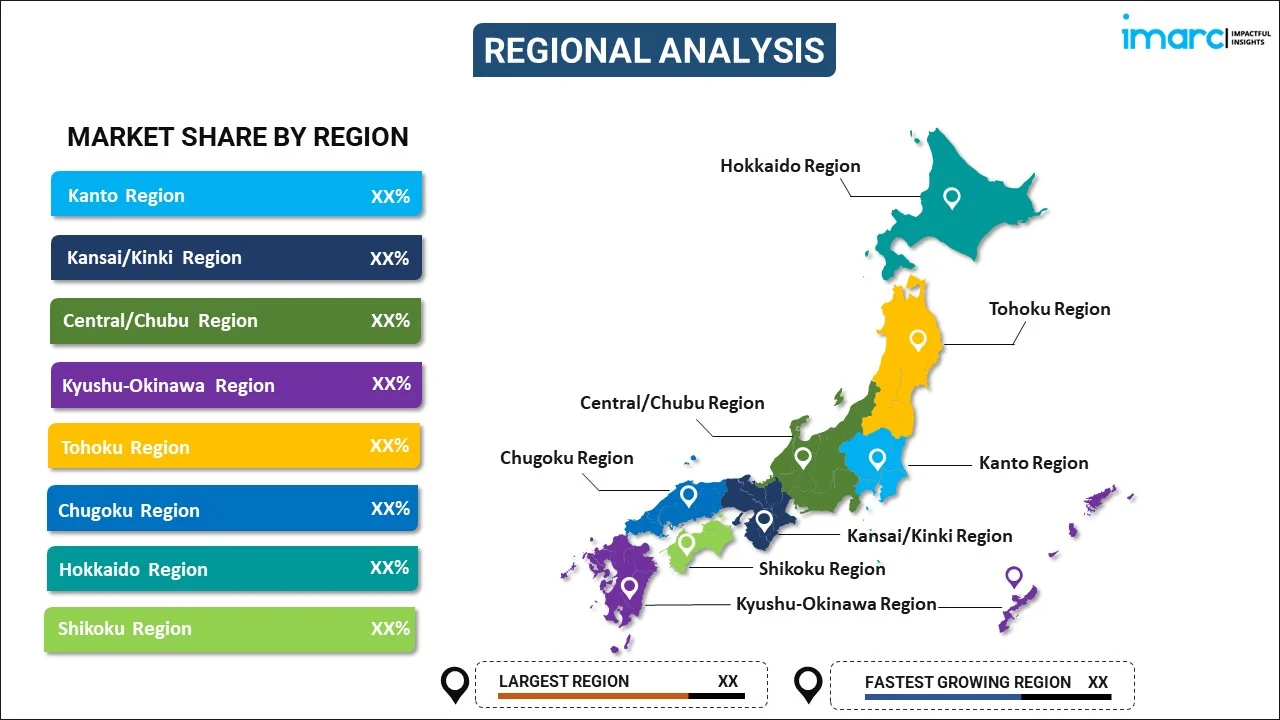
Japan Ceramics Market Report by Product (Traditional, Advanced), Application (Tiles, Sanitary Wares, Abrasives, Pottery, Bricks and Pipes, and Others), End Use (Building and Construction, Industrial, Medical, and Others), and Region 2025-2033
Market Overview:
Japan ceramics market is projected to exhibit a growth rate (CAGR) of 5.3% during 2025-2033. Increased utilization of the product within the construction sector, a rising preference for renewable energy solutions, and technological advancements in manufacturing processes for intricate shapes and cost-efficient production are among the primary factors propelling market growth.
|
Report Attribute
|
Key Statistics
|
|---|---|
|
Base Year
|
2024 |
|
Forecast Years
|
2025-2033 |
|
Historical Years
|
2019-2024
|
| Market Growth Rate (2025-2033) | 5.3% |
Ceramics are inorganic materials that lack metallic properties and are typically composed of a blend of clay, minerals, and other raw substances. They are renowned for their resistance to high temperatures, hardness, strength, and their capacity to endure wear and corrosion. Ceramics can be categorized into two primary types: traditional ceramics and advanced ceramics. Traditional ceramics encompass clay-based items like pottery, porcelain, and bricks, traditionally crafted by shaping clay and then subjecting it to high-temperature firing to achieve a solid, rigid structure. In contrast, advanced ceramics, often referred to as engineered or technical ceramics, constitute a class of ceramics that have been deliberately engineered to possess exceptional properties and performance attributes. They are produced from refined and processed raw materials using sophisticated manufacturing processes. Consequently, ceramics exhibit remarkable mechanical strength, resistance to high temperatures and chemicals, electrical insulation properties, and biocompatibility.
Japan Ceramics Market Trends:
The Japanese ceramics market is primarily energized by the burgeoning construction sector. Ceramics hold a significant presence in construction, finding application in tiles, sanitaryware, bricks, and refractories. Additionally, the surge in urbanization and infrastructure development in emerging economies, alongside renovation and refurbishment activities in developed regions, is driving the demand for ceramics within the construction domain. Furthermore, ceramics are gaining ground in the automotive industry, where they are utilized in components like catalytic converters, sensors, and engine parts. The automotive sector's quest for lightweight, durable, and high-temperature resistant materials, aimed at enhancing fuel efficiency, reducing emissions, and improving performance, is fostering the adoption of ceramics, particularly advanced ceramics. Moreover, the growing emphasis on renewable energy sources is contributing to market expansion. Besides this, the healthcare and biomedical sectors are also fueling market growth, as ceramics are widely embraced due to their biocompatibility and resilience to wear and corrosion. Notably, the development of advanced manufacturing techniques, such as additive manufacturing (3D printing), has broadened the horizons for ceramics, enabling intricate shapes, customization, and cost-effective production, which is expected to fuel the market growth in the coming years.
Japan Ceramics Market Segmentation:
IMARC Group provides an analysis of the key trends in each segment of the market, along with forecasts at the country level for 2025-2033. Our report has categorized the market based on product, application, and end use.
Product Insights:

- Traditional
- Advanced
The report has provided a detailed breakup and analysis of the market based on the product. This includes traditional and advanced.
Application Insights:
- Tiles
- Sanitary Wares
- Abrasives
- Pottery
- Bricks and Pipes
- Others
A detailed breakup and analysis of the market based on the application have also been provided in the report. This includes tiles, sanitary wares, abrasives, pottery, bricks and pipes, and others.
End Use Insights:
- Building and Construction
- Industrial
- Medical
- Others
The report has provided a detailed breakup and analysis of the market based on the end use. This includes building and construction, industrial, medical, and others.
Regional Insights:

- Kanto Region
- Kansai/Kinki Region
- Central/ Chubu Region
- Kyushu-Okinawa Region
- Tohoku Region
- Chugoku Region
- Hokkaido Region
- Shikoku Region
The report has also provided a comprehensive analysis of all the major regional markets, which include Kanto Region, Kansai/Kinki Region, Central/ Chubu Region, Kyushu-Okinawa Region, Tohoku Region, Chugoku Region, Hokkaido Region, and Shikoku Region.
Competitive Landscape:
The market research report has also provided a comprehensive analysis of the competitive landscape. Competitive analysis such as market structure, key player positioning, top winning strategies, competitive dashboard, and company evaluation quadrant has been covered in the report. Also, detailed profiles of all major companies have been provided. Some of the key players include:
- AGC Inc.
- Ceravision Kato Co. Ltd.
- KANO Corporation
- NGK Insulators Ltd.
- Nippon Electric Glass Co. Ltd.
- Niterra Co. Ltd.
- TOTO Ltd.
- Yamase Co. Ltd.
(Please note that this is only a partial list of the key players, and the complete list is provided in the report.)
Japan Ceramics Market Report Coverage:
| Report Features | Details |
|---|---|
| Base Year of the Analysis | 2024 |
| Historical Period | 2019-2024 |
| Forecast Period | 2025-2033 |
| Units | Million USD |
| Scope of the Report | Exploration of Historical Trends and Market Outlook, Industry Catalysts and Challenges, Segment-Wise Historical and Future Market Assessment:
|
| Products Covered | Traditional, Advanced |
| Applications Covered | Tiles, Sanitary Wares, Abrasives, Pottery, Bricks and Pipes, Others |
| End Uses Covered | Building and Construction, Industrial, Medical, Others |
| Regions Covered | Kanto Region, Kansai/Kinki Region, Central/ Chubu Region, Kyushu-Okinawa Region, Tohoku Region, Chugoku Region, Hokkaido Region, Shikoku Region |
| Companies Covered | AGC Inc., Ceravision Kato Co. Ltd., KANO Corporation, NGK Insulators Ltd., Nippon Electric Glass Co. Ltd., Niterra Co. Ltd., TOTO Ltd., Yamase Co. Ltd., etc. |
| Customization Scope | 10% Free Customization |
| Post-Sale Analyst Support | 10-12 Weeks |
| Delivery Format | PDF and Excel through Email (We can also provide the editable version of the report in PPT/Word format on special request) |
Key Questions Answered in This Report:
- How has the Japan ceramics market performed so far and how will it perform in the coming years?
- What has been the impact of COVID-19 on the Japan ceramics market?
- What is the breakup of the Japan ceramics market on the basis of product?
- What is the breakup of the Japan ceramics market on the basis of application?
- What is the breakup of the Japan ceramics market on the basis of end use?
- What are the various stages in the value chain of the Japan ceramics market?
- What are the key driving factors and challenges in the Japan ceramics?
- What is the structure of the Japan ceramics market and who are the key players?
- What is the degree of competition in the Japan ceramics market?
Key Benefits for Stakeholders:
- IMARC’s industry report offers a comprehensive quantitative analysis of various market segments, historical and current market trends, market forecasts, and dynamics of the Japan ceramics market from 2019-2033.
- The research report provides the latest information on the market drivers, challenges, and opportunities in the Japan ceramics market.
- Porter's five forces analysis assist stakeholders in assessing the impact of new entrants, competitive rivalry, supplier power, buyer power, and the threat of substitution. It helps stakeholders to analyze the level of competition within the Japan ceramics industry and its attractiveness.
- Competitive landscape allows stakeholders to understand their competitive environment and provides an insight into the current positions of key players in the market.
Need more help?
- Speak to our experienced analysts for insights on the current market scenarios.
- Include additional segments and countries to customize the report as per your requirement.
- Gain an unparalleled competitive advantage in your domain by understanding how to utilize the report and positively impacting your operations and revenue.
- For further assistance, please connect with our analysts.
 Inquire Before Buying
Inquire Before Buying
 Speak to an Analyst
Speak to an Analyst
 Request Brochure
Request Brochure
 Request Customization
Request Customization




.webp)




.webp)












